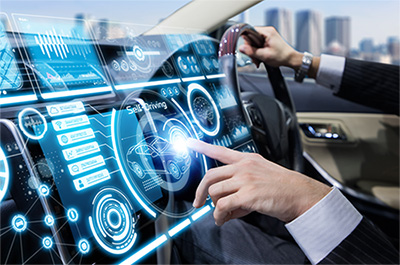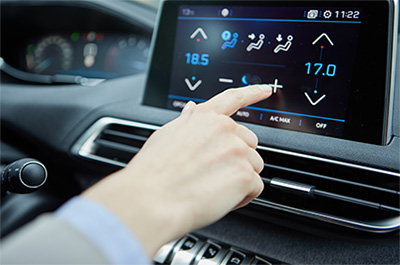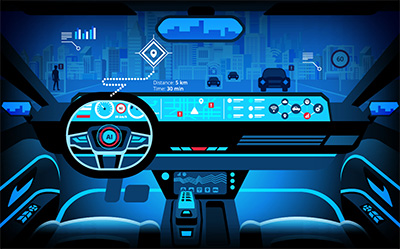What is an in-vehicle infotainment and an integrated cockpit, and what are the challenges for interior displays to realizing it? The specific measures to solve these issues are explained. It is explained how they should be solved in the face of demands for higher resolution, multiple displays, and functional safety.
What is an In-Vehicle Infotainment (IVI)?
"In-vehicle infotainment (IVI)" supports driving as well a comfort by providing information and entertainment towards the driver and the passengers.
In order to understand this concept, it is essential to know the meaning of "infotainment". "Infotainment" is a term used in this market which combines the words "information" and "entertainment".
"In-vehicle infotainment" provides these things when needed.
What types of information which drivers and passengers require are typical informations to support driving such as navigation and road traffic information. Besides that, entertainment, content playback, such as music and movies as well.
And in the future, when automobiles are generally gets connected to high-speed Internet, we will be able see even more.
For example read news, retrieve files stored in the cloud, download movies, download music, and operate our cars using voice recognition, those things that we do now with our computers and smartphones with more comfort and seamless.

Download materials for Epson's Automotive Display Controllers
Download product overview documents for Epson's Display Controllers that suport the development In-Vehcle Display Systems
- Product overview of a Telltale Monitoring IC that detect display errors.
- Product overview of a HUD controller IC with warping correction,display safety features and pitch correction.
- Product overview of a Scaler IC that realize higher/lower resolution display using existing SoC.
- Product overview of a eDP to OpenLDI Bridge IC
What is an In-Vehicle Infotainment System?
The term "in-vehicle infotainment system" refers to the various mechanisms that make in-vehicle infotainment possible.
To be more specific, it is a system that receives user operations via switches, touch panels, voice and processes necessary information and then outputs it to speakers or displays. It is based on various hardware and software.
Among these components, the display that shows various types of information plays the important role.
*"In-vehicle infotainment" refers to "navigation, etc. + audio/visual," in general, but in the description here includes "meter/instrumental cluster display".
What is a Center Information Display (CID)?
"Center Information Display" is a large display located in the center of the cockpit. It displays navigation and entertainment information which are essential to realize the in-vehicle infotainment. It is expected to become larger with higher resolution size, and more numbers of displays in the future.

What is a meter/instrumental cluster display?
"Meter/Instrumental cluster display" is a display located behind the steering wheel. In some cases it is called an instrumental cluster display. It displays driving speed, battery levels, engine/motor RPM, fuel consumption, and various telltales/warning lights. Much of this information relates to driving safety, so it requires assurance that it is displayed correctly.

What is a Head Up Display (HUD)?
"Head up display" is a display that shows information by projecting it on the windshield. It may be easier to understand if you think of it as display on some portion of the windshield.
The head up display typically shows driving information such as speed and gasoline/battery level, as well as simplified information from the navigation. For this , Drivers can continue driving without looking down.
Due to emerge of Head up display with augmented reality (AR) technology, the head up display is recently getting more advanced. For example, instead of simply projecting navigation information, AR displays can show arrows indicating the direction of travel in line with the actual road seen beyond the windshield, making recognition more intuitive. This kind of next-generation head up display is expected to become a mainstream in the future.

What is the latest trend in head-up displays, "panoramic HUD"?
What is a panoramic hud (panorama hud)?
This section describes the panoramic HUD, which has recently become a hot topic. This is different from conventional HUDs. It is a new type of display that projects the image of a display embedded in the dashboard onto a special black coating on the lower part of the windshield with high light intensity.This type of display is attracting a lot of attention these days, as it does not require a complex optical mechanism like a HUD and allows the user to see the necessary information with a high contrast display while keeping the line of sight forward. In addition, as the projection is possible across the full width of the windshield, a wide range of content can be displayed in addition to the conventional displays provided by meters and HUDs.
Future vision of an Automobile with "In-Vehicle Infotainment"
Some of this has already been achieved through the linkage between the in-vehicle infotainment and advanced driver assistance systems (ADAS).
Object detection, such as pedestrians or another vehicle, is one example. The system detects danger by utilizing sensors and high-precision GPS installed in the car. The system not only displays the information on the display, but also assists braking. In addition, system monitors the driver to realize safety driving support. The driver's condition is monitored in real time by image sensors and heart rate sensors built into the seats and other parts of the vehicle.If the system determines that the driver is drowsy or inattentive, , it alerts the driver to avoid danger through warning sounds and seat vibrations.
There are things that have been realized with the entertainment sector as well. For example, downloading high-quality music from your smartphone. By playing the music through a car audio system connected to high-spec speakers, you can enjoy the music in the car as if being in a concert hall.
As in-vehicle infotainment evolves further in the future, there would be more new possibilities emerging as well.
This is just an example, but it may be possible for a car to recognize the schedule registered in the driver's smartphone and automatically set the navigation system. or play music of the driver's choice. Combined with self-driving technology, drivers will be able to eat, chat, play games, and work just as they would at home or in the office.
As in-vehicle infotainment evolves, the time that used to be spent on transportation can now be spent freely.
What is an Integrated Cockpit?
An integrated cockpit refers to an integrated management of display with various information, including information displayed on meter/instrument cluster as well as the information displayed on center information displays and head up displays. Furthermore the integrated management recently includes information such as advanced driver assistance systems (ADAS) ,driver monitoring systems (DMS), and is expected to become widespread. Until now, meters/instrument clusters and infotainment have been a separate units, but in the "integrated cockpit," everything is controlled by a single ECU. This will make it possible to display the necessary information at the necessary timing on the most appropriate display, contributing to improved safety and convenience for the driver and passengers.

Challenges for displays in a In-Vehicle Infotainment
As in-vehicle infotainment has evolved, there have been challenges with the display areas.
*In general, "in-vehicle infotainment" refers to "navigation, etc. + audio/visual," but here within includes "meter/instrumental cluster display”.

Larger and higher resolution size displays
First, displays size are becoming larger as well as the resolution. In the past, automobile displays were used to show limited information such as the time, navigation system, and song titles. As the number of display contents increased, such as images on the rear-view monitor, remaining motor battery level, and driver operation trends, the displays size have become larger and higher resolution.
The entire system must be made to a higher specification, in order to display such various information on the larger display. Therefore, the challenge is how to respond to the increasing size and resolution of displays.
Multiple displays (multi-display)
Multiple displays is another challenge. In addition to the center information display and meter/instrumental cluster display, automobiles now have more displays, including a head up display. Of course, the convenience of having more information displayed has greatly increased. However, there may be some aspects where it has become difficult to know what information is displayed on which display.
Also multiple displays are being combined to build into one large display. For example, a center information display was usually a single display, however, as the information increased, several displays have been combined to form a single display. User convenience has increased, but the technical problem of distributing a single video signal to multiple displays must be solved.
Safety measures for digital meters/instrumental cluster
Meter/instrumental cluster displays used to show speed, engine rpm, and etc. in an analog manner. These days, digital displays on LCD screens placed partially or fully on the meter are becoming the mainstream.
What is important to pay attention is the information related to safety such as telltales/warning lights, gasoline, battery level, seat belt, half door, and side brake. The safety of the driver and passengers can be seriously endanged if the display continues to show incorrect information . To prevent this from happening, the entire system must have a mechanism to detect when a display is malfunctioning.
Features of Epson's In-Vehicle Display Controllers
Epson offers a lineup of in-vehicle display controllers with a variety of functions that contribute to the realization of in-vehicle infotainment and integrated cockpits. A key feature is the ability of adapting to various display needs.
Images on a display are displayed by outputting video signals from the SoC (System on a Chip) to the display. However, as in-vehicle infotainment has evolved, inconsistencies is occurring between the signals from the SoC to the display. Placing Epson's in-vehicle display controller between the SoC and the display solves these problems.
S2D13V52 for larger displays and higher resolutions
S2D13V52 Scaler IC is a display controller that enlarges or reduces the size of an image.
For example, a SoC with a maximum output resolution of 1280x480 cannot display 1920x720. The user must have a SoC capable of 1920x720 output.
The role of the "S2D13V52 Scaler IC" is to fill this gap, by placing a scaler IC between the SoC and the display. The 1280 x 480 signal can be converted up to 1920 x 720 signal to the display with an algorithm which minimizes degradation. This allows user to utilize the existing SoCs environment and still create a higher resolution and higher quality display systems.
S2D13V02 for detecting video errors with alerts
The "S2D13V02 error detection IC" monitors the video signal for errors. When an error is detected, it notifies the SoC in parallel with performing the necessary image processing.
Meter/instrumental cluster displays with a full LCDs are increasingly, especially in high-end vehicles. However, an error in the telltales/warning lights display on a meter/instrumental cluster display can serious danger to the safety of the driver and passengers. So, if for some reason there were to be an error detected, the display will be blacked out or give an error message so that it allows the driver to quickly realize that a problem.
S2D13V70 to bridges SoCs and displays with different video signal standards
"S2D13V70 bridge IC" that solves the mismatch of video signal standards between the SoCs and displays.
DP or eDP is becoming more and more common as the standard for video signals output by SoCs. On the other hand, Open LDI has been the mainstream standard for signals that can be input to the displays. By placing a bridge IC between the SoC and the display, can solve the mismatch between these standards.
The S2D13V70 can be used as a splitter to split the video signal from the SoC and output separate images to two displays.
S2D13V40 Head up Display Controller
A head up display a method display contents on the windshield. It mainly displays speed, navigation information, gasoline and battery level, etc. However, simply projecting the signal output by the SoC is not enough to properly display the information. This is because the windshield is a curved surface and distortion will occur.
The S2D13V40 Head Up Display Controller solves this problem by pre-correcting the image in the controller. It projects a distortion-free image on the windshield.
Display Controller IC/Interface IC for Automotive TOP
Download materials for Epson's Automotive Display Controllers
Download product overview documents for Epson's Display Controllers that suport the development In-Vehcle Display Systems
- Product overview of a Telltale Monitoring IC that detect display errors.
- Product overview of a HUD controller IC with warping correction,display safety features and pitch correction.
- Product overview of a Scaler IC that realize higher/lower resolution display using existing SoC.
- Product overview of a eDP to OpenLDI Bridge IC
